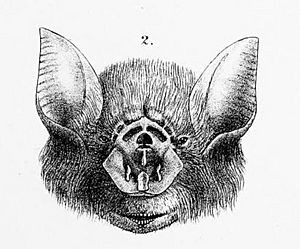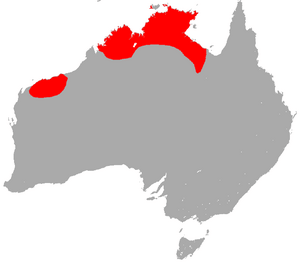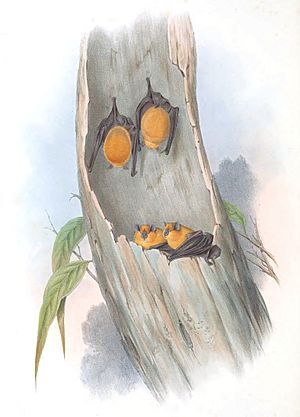Orange leaf-nosed bat facts for kids
Quick facts for kids Orange leaf-nosed bat |
|
|---|---|
 |
|
| Conservation status | |
| Scientific classification | |
 |
|
| Orange leaf-nosed bat range |
The orange leaf-nosed bat (Rhinonicteris aurantia) is a type of bat that lives in Australia. It's the only living species in its group, called Rhinonicteris. These bats are special because they are found only in Australia, mostly in the far north and north-west parts of the country. They like to sleep in caves and old mines. Their favorite food is moths, and they are very sensitive to people disturbing their homes.
Contents
About the Orange Leaf-nosed Bat
A small bat, the orange leaf-nosed bat usually weighs between 7 and 11 grams. They live in large groups, sometimes thousands of them, in underground places like caves and old mines. Their fur can be different colors, like brownish, reddish-orange, lemon-yellow, or even white! Their forearm (part of their wing) is about 42 to 46 millimeters long.
These bats have a special feature on their face called a 'nose-leaf'. It's wide and flat at the bottom, with a gap in the middle. It looks a bit like a horseshoe. The top part of this nose-leaf is wavy, and they have deep holes for their nostrils. Behind this nose-leaf is a special gland that makes a secretion.
Their ears are smaller than those of similar bats and are sharply pointed at the top. From head to body, these bats measure about 43 to 53 millimeters long.
How Scientists Classify Them
Scientists group living things into categories, and the orange leaf-nosed bat belongs to a family called Hipposideridae. This family includes other 'leaf-nosed bats'. The first time this bat was officially described was in 1845 by a scientist named John Edward Gray.
The very first bat specimen used to describe the species is kept at the Natural History Museum, London. It was collected near a place called Port Essington in Australia.
Scientists have found that bats from the western part of Australia, in an area called Pilbara, are a bit different from the northern bats. They look similar but have different DNA. This means they might be a separate type of orange leaf-nosed bat.
People also call this bat the golden or orange horseshoe bat.
Where They Live
The orange leaf-nosed bat lives across the northern part of Australia. This includes the Top End and Kakadu National Park in the Northern Territory. Their home also stretches into Western Australia and north-west Queensland.
There's a separate group of these bats in the Pilbara region of north-west Australia. The westernmost place they are found is around Derby, Western Australia, and their range goes east to Lawn Hill, Queensland.
One place known for a very large group of these bats, with thousands of them, is Tolmer Falls in Litchfield National Park. They also like big limestone caves in the Kimberley region, where the biggest groups live. At Tunnel Creek, these bats share their home and hunt with several other bat species.
Sometimes, these bats fly close to the ground and can accidentally get hit by large trucks called road trains.
What They Eat and How They Live
Like many bats in dry areas, orange leaf-nosed bats are insectivores, meaning they eat insects.
R. aurantia often shares large caves with other bat species. These include the yellow-lipped bat (Vespadelus douglasorum), the northern bentwing bat (Miniopterus orianae), the western cave bat, and the ghost bat (Macroderma gigas). They prefer warm and humid caves, but can also roost in tree hollows. A group can have thousands of bats, but they also gather in smaller clusters of twenty or more.
Their diet includes different kinds of beetles, weevils, bugs, wasps, and ants. However, their favorite food is moths. They fly out several times during the night to hunt for food.
Sometimes, tiny organisms called parasites can live on these bats. For example, a tiny creature called Opthalmodex australiensis was found near their eyes. Another tiny creature, Chiroptella geikiensis, which is a type of chigger, was also found on them.
These bats are very sensitive to people visiting their roosts. If disturbed, a whole group might leave their home. Threats to these bats include their homes being destroyed by mining, or land being cleared for farming and raising animals. This clearing means they lose places to live and food sources.
Scientists have found fossils of a bat called Brachipposideros nooraleebus at the Riversleigh site in Northern Queensland. These ancient bats look a lot like the orange leaf-nosed bat.
The conservation status of the orange leaf-nosed bat is currently "least concern". This means they are not in immediate danger of disappearing. However, the group of bats found in the Pilbara region is considered vulnerable to extinction.
See also
 In Spanish: Rhinonicteris aurantia para niños
In Spanish: Rhinonicteris aurantia para niños



